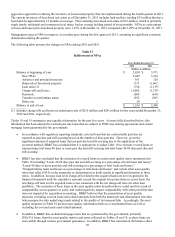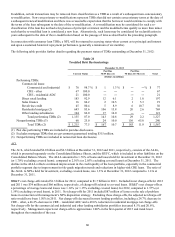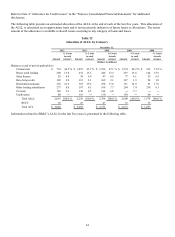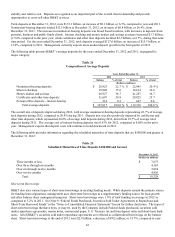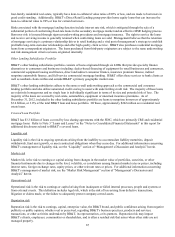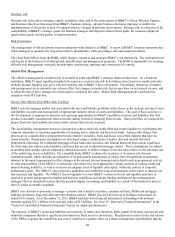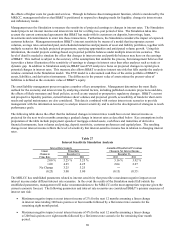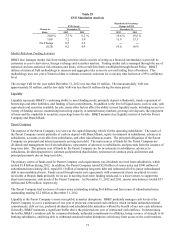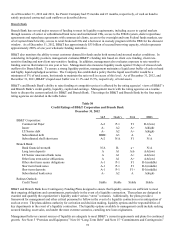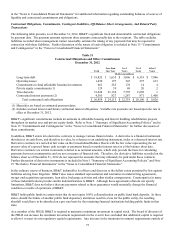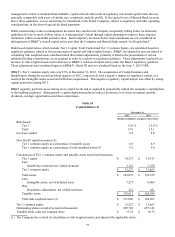BB&T 2012 Annual Report Download - page 87
Download and view the complete annual report
Please find page 87 of the 2012 BB&T annual report below. You can navigate through the pages in the report by either clicking on the pages listed below, or by using the keyword search tool below to find specific information within the annual report.
65
portfolio, partially offset by declines of $111 million related to pensions and other post-retirement benefit plans and $61
million related to an increase in amounts attributable to the FDIC under loss share agreements.
BB&T’ s tangible book value per common share at December 31, 2012 was $17.52 compared to $16.73 at December 31,
2011. As of December 31, 2012, measures of tangible capital were not required by the regulators and, therefore, were
considered non-GAAP measures. Refer to the section titled “Capital” herein for a discussion of how BB&T calculates and
uses these measures in the evaluation of the Company.
Risk Management
In the normal course of business BB&T encounters inherent risk in its business activities. Risk is managed on a
decentralized basis with risk decisions made as closely as possible to where the source of risk occurs. Centrally, risk
oversight is managed at the corporate level through oversight, policies and reporting. The principal types of inherent risk
include regulatory, credit, liquidity, market, operational, reputation and strategic risks.
Regulatory risk
Regulatory risk is the risk to earnings, capital, or reputation arising from violations of, or nonconformance with current and
changing laws, regulations, supervisory guidance, regulatory expectations, or the rules, standards, or codes of conduct of self
regulatory organizations.
Credit risk
Credit risk is the risk to earnings or capital arising from the default, inability or unwillingness of a borrower, obligor, or
counterparty to meet the terms of any financial obligation with BB&T or otherwise perform as agreed. Credit risk exists in
all activities where success depends on the performance of a borrower, obligor, or counterparty. Credit risk arises when
BB&T funds are extended, committed, invested, or otherwise exposed through actual or implied contractual agreements,
whether on or off the balance sheet. Credit risk also occurs when the credit quality of an issuer whose securities or other
instruments the bank holds deteriorates.
BB&T has established the following general practices to manage credit risk:
limiting the amount of credit that individual lenders may extend to a borrower;
establishing a process for credit approval accountability;
careful initial underwriting and analysis of borrower, transaction, market and collateral risks;
ongoing servicing and monitoring of individual loans and lending relationships;
continuous monitoring of the portfolio, market dynamics and the economy; and
periodically reevaluating the bank’ s strategy and overall exposure as economic, market and other relevant conditions
change.
The following discussion presents the principal types of lending conducted by BB&T and describes the underwriting
procedures and overall risk management of BB&T’ s lending function.
Underwriting Approach
Recognizing that the loan portfolio is a primary source of profitability and risk, proper loan underwriting is critical to
BB&T’ s long-term financial success. BB&T’ s underwriting approach is designed to define acceptable combinations of
specific risk-mitigating features that ensure credit relationships conform to BB&T’ s risk philosophy. Provided below is a
summary of the most significant underwriting criteria used to evaluate new loans and loan renewals:
Cash flow and debt service coverage—cash flow adequacy is a necessary condition of creditworthiness, meaning that
loans must either be clearly supported by a borrower’ s cash flow or, if not, must be justified by secondary repayment
sources.
Secondary sources of repayment—alternative repayment funds are a significant risk-mitigating factor as long as they are
liquid, can be easily accessed and provide adequate resources to supplement the primary cash flow source.



